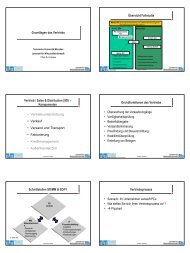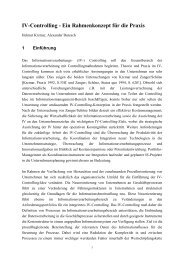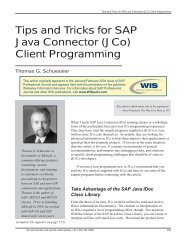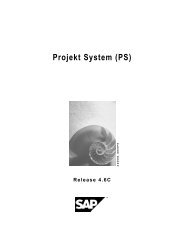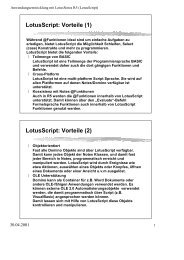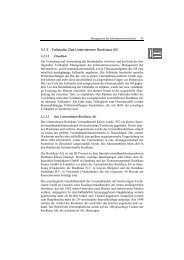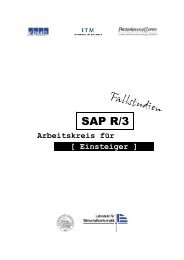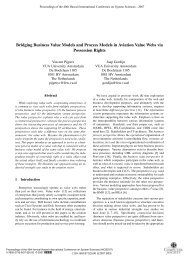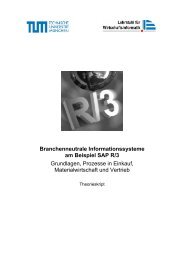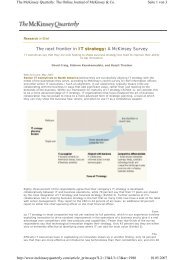Overview and Implementing SAP Software in Organizations ...
Overview and Implementing SAP Software in Organizations ...
Overview and Implementing SAP Software in Organizations ...
Create successful ePaper yourself
Turn your PDF publications into a flip-book with our unique Google optimized e-Paper software.
Different Views upon <strong>SAP</strong> = Course RoadmapEnterprise <strong>Software</strong> <strong>Software</strong> <strong>in</strong> <strong>in</strong> a a Nutshell Nutshell<strong>Overview</strong> <strong>and</strong> <strong>Implement<strong>in</strong>g</strong><strong>SAP</strong> <strong>Software</strong> <strong>in</strong> <strong>in</strong> <strong>Organizations</strong>Technische Universität MünchenChair for Information Systems© Prof. Dr. H. KrcmarDr. WittgesDr. WittgesCIO„Why deal with <strong>SAP</strong> ?“Application Consultant„How toimplement <strong>SAP</strong> ?“H. JehleTechnical Support„What <strong>in</strong>frastructuredoes <strong>SAP</strong> need ?“A. MorsM. MohrEnd User„How will <strong>SAP</strong>support my tasks ?“V. NicolescuService Provider„How to operate<strong>and</strong> provide <strong>SAP</strong>Solutions ?“Technical Consultant„How does <strong>SAP</strong> work ?“© Prof. Dr. H. KrcmarLecturerAgendaDr. Holger Wittges,Dipl.-Wirtsch.InfTechnische Universität MünchenLehrstuhl für Wirtschafts<strong>in</strong>formatik - I17HCC - <strong>SAP</strong> HochschulkompetenzzentrumBoltzmannstr. 3D-85748 Garch<strong>in</strong>gTel. +49 (0)89 289-19540Fax +49 (0)89 289-19533E-Mail: holger.wittges@<strong>in</strong>.tum.deHomepage: www.hcc.<strong>in</strong>.tum.de1. <strong>Overview</strong> Enterprise <strong>Software</strong> & ERP Systems2. Important <strong>SAP</strong> Solutions3. <strong>SAP</strong> NetWeaver4. Us<strong>in</strong>g Bus<strong>in</strong>ess Process Models to implement ERPWorkflow with<strong>in</strong> <strong>SAP</strong> <strong>Software</strong>5. <strong>SAP</strong> Solution Map6. Case Study – <strong>Implement<strong>in</strong>g</strong> <strong>SAP</strong> <strong>Software</strong> <strong>in</strong><strong>Organizations</strong>© Prof. Dr. H. Krcmar© Prof. Dr. H. KrcmarDef<strong>in</strong>itions ERP1. 1. <strong>Overview</strong> Enterprise <strong>Software</strong> &ERP Systems• „ERP (enterprise resource plann<strong>in</strong>g systems) comprises of a commercial softwarepackage that promises the seamless <strong>in</strong>tegration of all the <strong>in</strong>formation flow<strong>in</strong>gthrough the company-f<strong>in</strong>ancial, account<strong>in</strong>g, human resources, supply cha<strong>in</strong><strong>and</strong> customer <strong>in</strong>formation)“ (Davenport, 1998)• „ERP systems are configurable <strong>in</strong>formation systems packages that <strong>in</strong>tegrate<strong>in</strong>formation <strong>and</strong> <strong>in</strong>formation-based processes with<strong>in</strong> <strong>and</strong> across functional areas<strong>in</strong> an organization“ (Kumar & Van Hillsgersberg, 2000)• “One database, one application <strong>and</strong> a unified <strong>in</strong>terface across the entireenterprise” (Tadjer, 1998)• “ERP systems are computer-based systems designed to process anorganization’s transactions <strong>and</strong> facilitate <strong>in</strong>tegrated <strong>and</strong> real-time plann<strong>in</strong>g,production, <strong>and</strong> customer response” (O’Leary, 2001)(Source: Rashid et al., 2000)© Prof. Dr. H. Krcmar
© Prof. Dr. H. KrcmarERP developmentCharacteristics of Enterprise <strong>Software</strong>Criticality20042000sSOAExtended ERP or ERP IIhighInfrastructure<strong>Software</strong>Bus<strong>in</strong>ess<strong>Software</strong>1990sEnterprise Resource Plann<strong>in</strong>g (ERP)1980sManufactur<strong>in</strong>g Resources Plann<strong>in</strong>g (MRPII)1970s1960sMaterial Requirements Plann<strong>in</strong>g (MRP)Inventory Control PackageslowOffice<strong>Software</strong>Source: Extend version of Rashid et al. 2000© <strong>SAP</strong> AGlowhighAdaptability© Prof. Dr. H. KrcmarA Variety of Enterprise ApplicationsAnatomy of an Enterprise System (ERP I)• Customer RelationshipManagement• Enterprise Resource Plann<strong>in</strong>g• Supply Cha<strong>in</strong> Management• E-Procurement & E-Markets• Data Warehous<strong>in</strong>g <strong>and</strong> Analytics• Portals <strong>and</strong> KnowledgeManagementCallCenterERPTrad<strong>in</strong>gTechnicalsystemsDocument MgmtMarketAnalysisPLMSCMe-SalesE-Procurement© <strong>SAP</strong> AGSales forceCustomers <strong>and</strong> customerservice repsSource: Davenport, 1998Sales <strong>and</strong>deliveryapplicationsServiceapplicationsManagers <strong>and</strong>StakeholdersReport<strong>in</strong>gapplicationsCentraldatabaseHumanresourcemanagementApplicationsEmployeesF<strong>in</strong>ancialapplicationsManufactur<strong>in</strong>g Back-officeapplications Adm<strong>in</strong>istrators<strong>and</strong> workersInvetory<strong>and</strong> supplyapplicationsSuppliers© Prof. Dr. H. Krcmar© Prof. Dr. H. KrcmarExtended ERPERP – Bus<strong>in</strong>ess View• Service oriented architecture• Integration of Middleware functionality• Support of more then one central DB• ERP II-System looks more like a open toolset rather than aclosed solution• The <strong>in</strong>tegration of all comput<strong>in</strong>g with<strong>in</strong> anorganization such that:• all major bus<strong>in</strong>ess processes areencompassed <strong>and</strong> st<strong>and</strong>ardized <strong>and</strong>• all data is usable by all functionalareas of the bus<strong>in</strong>ess• Enterprise Resource Plann<strong>in</strong>g = ERP• Integrate many bus<strong>in</strong>ess functions<strong>in</strong>to one seamless application• Usually are applications systemsthat run on top of a RDBMS• Replace 100s of legacy systems <strong>in</strong>organizations who use an ERPSource: CSU Chico© Prof. Dr. H. Krcmar© Prof. Dr. H. Krcmar
© Prof. Dr. H. KrcmarERP – Technical ViewERP Suites• What are Enterprise Resource Plann<strong>in</strong>g (ERP) Systems?• Incredibly large, extensive software packages used to manage afirm’s bus<strong>in</strong>ess processes.• St<strong>and</strong>ard software packages that must be configured to meet theneeds of a company• Database programs with the follow<strong>in</strong>g functions:- Input- Storage/Retrieval28,610+ Tables <strong>in</strong> <strong>SAP</strong>- Manipulation- Output• Core Applications• F<strong>in</strong>ancials• Human Resources (HR)• Manufactur<strong>in</strong>g• Project Management• Extended ERP• Bus<strong>in</strong>ess Intelligence• Customer Relationship Management (CRM)• Sales Force Automation (SFA)• Supply Cha<strong>in</strong> Management (SCM)• E-Logistics• E-Procurement• Product Life-cycle Management (PLM)• Internet Transformation for ERP• Portals• Exchanges – B2B• Mobile Access© Prof. Dr. H. KrcmarERP functions: examplesWhat is Enterprise Resource Plann<strong>in</strong>g ?F<strong>in</strong>ancialsAccounts payableAsset managementAccounts receivablebudget<strong>in</strong>gManufactur<strong>in</strong>gProduction schedul<strong>in</strong>g Quality controlShop floor executiongeneral ledgerDem<strong>and</strong> forecast<strong>in</strong>gBill of materialsShop flow management Job cost account<strong>in</strong>gProject ManagementPlann<strong>in</strong>g schedulesHRTrack<strong>in</strong>g project costEmployee <strong>in</strong>formationContracts, resourcesDecision SupportExecutive ISSales &Market<strong>in</strong>gManufactur<strong>in</strong>gSource: based on Mertens 2001, Abb. 1.1/3 S.5HRAccount<strong>in</strong>g &F<strong>in</strong>anceStrategic InformationProcurementOne Integrated Information SystemManagerial InformationTransactionInformation© Prof. Dr. H. Krcmar© Prof. Dr. H. KrcmarAdvantages of ERP systemsDisadvantages of ERP systemsWhat benefitReliable <strong>in</strong>formation accessAvoid data <strong>and</strong> operationsredundancyDelivery <strong>and</strong> cycle timereductionCost reductionEasy adaptabilityImproved scalabilityImproved ma<strong>in</strong>tenanceGlobal outreachE-Commerce, e-bus<strong>in</strong>essSource: Rashid et al. 2000HowCommon DBMS, consistent <strong>and</strong> accurate data, improved reports.Modules access same data from the central database, avoid multipledata <strong>in</strong>put <strong>and</strong> update operations.M<strong>in</strong>imizes retriev<strong>in</strong>g <strong>and</strong> report<strong>in</strong>g delaysTime sav<strong>in</strong>gs, improved control by enterprise-wide analysis oforganizational decisions.Changes <strong>in</strong> bus<strong>in</strong>ess processes easy to adapt <strong>and</strong> restructureStructured <strong>and</strong> modular design with “add-ons”Vendor-supported long-term contract as part of the system procurementExtended modules such as CRM <strong>and</strong> SCMInternet commerce, collaborative cultureDisadvantagesTime-consum<strong>in</strong>gExpensiveConformity of the modulesVendor dependenceFeatures <strong>and</strong> complexityScalability <strong>and</strong> global outreachExtended ERP capabilitySource: Rashid et al. 2000How to overcomeM<strong>in</strong>imize sensitive issues, <strong>in</strong>ternal politics <strong>and</strong> raise generalconsensusCost may vary from thous<strong>and</strong>s of dollars to millions. Bus<strong>in</strong>essprocess reeng<strong>in</strong>eer<strong>in</strong>g cost may be extremely high.The architecture <strong>and</strong> components of the selected system shouldconform to the bus<strong>in</strong>ess processes, culture <strong>and</strong> strategic goals ofthe organization.S<strong>in</strong>gle vendor vs. multi-vendor consideration, options for “best ofbreeds”, long-term committed support.ERP systems may have to many features <strong>and</strong> modules so the userneeds to consider carefully <strong>and</strong> implement the needful only.Look for vendor <strong>in</strong>vestment <strong>in</strong> R&D, long-term commitment toproduct <strong>and</strong> services, consider Internet enabled systems.Consider middle-ware “add-on” facilities <strong>and</strong> extend modules suchas CRM <strong>and</strong> SCM.© Prof. Dr. H. Krcmar© Prof. Dr. H. Krcmar
What is <strong>SAP</strong> R/3 ?2. 2. Important <strong>SAP</strong> Solutions• <strong>SAP</strong> is an example of an ERP System• <strong>SAP</strong> R/3• <strong>SAP</strong>’s Client Server version (Distributes process <strong>and</strong> presentation)• Based on R/2 (Ma<strong>in</strong>frame version - centralization of data <strong>and</strong>process)• R/3 4.0: release (May 1998) distributes data, process, <strong>and</strong>presentation• R/3 4.7: first release, based on NetWeaver components• my<strong>SAP</strong> ERP 2003• my<strong>SAP</strong> ERP 2004© Prof. Dr. H. Krcmarmy<strong>SAP</strong> ERP with<strong>in</strong> my<strong>SAP</strong> Bus<strong>in</strong>ess SuiteArchitekture of my<strong>SAP</strong> ERP© <strong>SAP</strong> AG© Prof. Dr. H. Krcmar© <strong>SAP</strong> AG© Prof. Dr. H. Krcmar<strong>SAP</strong> Solutions• Onl<strong>in</strong>e demo:• http://www.sap.com3. 3. NetWeaver© Prof. Dr. H. Krcmar
© Prof. Dr. H. Krcmar<strong>SAP</strong> NetWeaver – A Logical Evolution<strong>SAP</strong> NetWeaver Platform© <strong>SAP</strong> AG© <strong>SAP</strong> AG, Annual Report 2004© Prof. Dr. H. Krcmar<strong>SAP</strong> NetWeaver - Product Roadmap4. 4. Us<strong>in</strong>g Bus<strong>in</strong>ess Process Models to to implementERP Workflow with<strong>in</strong> <strong>SAP</strong> <strong>Software</strong>© <strong>SAP</strong> AG© Prof. Dr. H. KrcmarUs<strong>in</strong>g Bus<strong>in</strong>ess Process Models to implement ERPWorkflow with<strong>in</strong> <strong>SAP</strong> <strong>Software</strong>Today Change is to costly <strong>and</strong> slow• Bus<strong>in</strong>ess Process Models describe the bus<strong>in</strong>ess• Workflows describe the technical implementation of theBPM us<strong>in</strong>g high level Application components© <strong>SAP</strong> AG© Prof. Dr. H. Krcmar© Prof. Dr. H. Krcmar
© Prof. Dr. H. Krcmar<strong>SAP</strong> Enterprise Services ArchitektureSolution Map• „<strong>SAP</strong>'s Solution Maps are well-def<strong>in</strong>ed tools that outl<strong>in</strong>e thescope of an organization's bus<strong>in</strong>ess. The Solution Mapsalso show how various processes are covered, <strong>in</strong>clud<strong>in</strong>gthe processes that <strong>SAP</strong> <strong>and</strong> its partners support“ <strong>SAP</strong>© <strong>SAP</strong> AG© Prof. Dr. H. KrcmarSolution Map NetWeaver Level 15) 5) <strong>SAP</strong> Solution Map© Prof. Dr. H. KrcmarSolution Map my<strong>SAP</strong> CRM Level 1Solution Map my<strong>SAP</strong> CRM Level 2http://www.sap.com/solutions/bus<strong>in</strong>essmaps/DEE27EBB1D564D8C800231FE6D54325D/<strong>in</strong>dex.aspx (18.1.2004)© Prof. Dr. H. Krcmar© Prof. Dr. H. Krcmar
© Prof. Dr. H. KrcmarQuestions…?6. 6. Case Study – <strong>Implement<strong>in</strong>g</strong> <strong>SAP</strong> <strong>Software</strong> <strong>in</strong> <strong>in</strong><strong>Organizations</strong><strong>Implement<strong>in</strong>g</strong> <strong>SAP</strong> <strong>Software</strong> <strong>in</strong> OrganisationsNIBCOS‘S „BIG BANG“ Project• NIBCO‘S „BIG BANG“Teach<strong>in</strong>g Case from: C. Brown & I. Vessey,2000, Indiana University.• Project Goals• Project Organization• Project Timel<strong>in</strong>e• Project Tasks• Discussion: Possible problems <strong>and</strong> how to avoid them© Prof. Dr. H. Krcmar© Prof. Dr. H. KrcmarProject GoalsProject Organisation• Enable IT-support for the new supply cha<strong>in</strong> <strong>and</strong> customerfac<strong>in</strong>gstrategies• Substitute a „patchwork of legacy systems <strong>and</strong> report<strong>in</strong>gtools“ with a new, <strong>in</strong>tegrated system for• ten plants <strong>and</strong>• four distribution centers• go live without consultants on 30 th of dec. 1997• big bang approach• „TIGER Triad“ -> Project Lead• „TIGER Den“ -> Workplace• Team size approx. 70 Members© Prof. Dr. H. Krcmar© Prof. Dr. H. Krcmar
© Prof. Dr. H. Krcmar01.08.1995 Start14 months plann<strong>in</strong>g30.09.1996 Kickoff15 months to implement30.12.1997 Go LiveProject Timel<strong>in</strong>eProject Tasks• Project Management• Def<strong>in</strong>e Bus<strong>in</strong>ess Responsibilities• F<strong>in</strong>ance <strong>and</strong> Controll<strong>in</strong>g• Material Management/Production Plann<strong>in</strong>g• Sales/Distribution• Change Management© Prof. Dr. H. KrcmarChange Management CategoriesDiscussion: Possible problems <strong>and</strong> how to avoid them• New• Automate• Elim<strong>in</strong>ate• Transfer• Risk• Difficulty• Relationships• Other© Prof. Dr. H. Krcmar© Prof. Dr. H. KrcmarLiteratur• Carol, Vessey: „NIBCO‘S BIG BANG“, 2000, IndianaUniversity.• Davenport: „Putt<strong>in</strong>g the Enterprise <strong>in</strong>to the EnterpriseSystem“, Harvard Bus<strong>in</strong>ess Review, 1998, p.121.• Rashid, Hossa<strong>in</strong>, Patrick: „The Evolution of ERP Systems:A Historical Perspective“, Idea Group Publish<strong>in</strong>g, 2000.• <strong>SAP</strong>: help.sap.com onl<strong>in</strong>e documentation.© Prof. Dr. H. Krcmar



